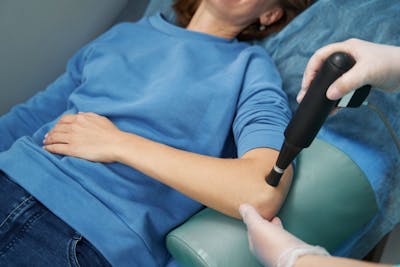
What is Radial Shockwave Therapy?
Radial Shockwave Therapy is a series of high-energy percussions to the affected area. It is a medical treatment that utilizes ultrasound technology to send the acoustic waves into a targeted area to stimulate the body's natural healing process.
How does it work?
- Treatment produces an inflammatory response. The body responds by increasing metabolic activity around the site of pain. This stimulates and accelerates the healing process (promotes the remodeling of dysfunctional collagenous tissues, such as tendinopathies, trigger points, muscle strains, etc.).
- Shockwaves break down scar tissue and/or calcification
- Transmission of pain is diminished through neurologic mechanisms
- At the most basic level, shockwave therapy stimulates new cell growth.
What is the success rate for this kind of treatment?
A successful treatment is considered as a patient having at least 75% reduction in pain within 3 months. Worldwide, success rates are around 80 to 90%.
How many sessions are needed?
Shockwave treatment has a cumulative effect on the injured tissue. Normally three to five treatments are necessary at weekly intervals; there is a possibility that a few more additional treatments may be necessary if your condition is very chronic and/or you have severely restricted joint range of motion.
How long does the session take?
The first session is half hour and includes an evaluation, discussion of the issue, explanation of treatment and the treatment itself. Subsequent sessions are approximately 20 minutes. The RST itself is approximately 5 minutes. Generally, 2000 shocks are administered per treatment area. However, some conditions require more shocks and duration, depending on severity and chronicity (how long the condition or injury has existed).
Treatment Costs:
Treatment cost is $120 for an initial half-hour session. Follow up sessions are $75 each. However, a treatment may cost more, depending on the number of shocks required and delivered. An additional 2000 shocks per treatment will cost $25 and slightly prolong the session. The number of shocks depends on the severity, chronicity and location(s) of the condition(s). Any necessary increases will be discussed with you beforehand and administered upon approval.
Does the treatment hurt?
It is a short treatment that may be uncomfortable. However, most people can easily tolerate the procedure. However, if you cannot tolerate it, adjustments on the machine can decrease the pressure you feel. For the initial session a comfort mode is used to slowly ramp up the intensity so the body becomes familiar with the sensation.
Will it hurt after the treatment?
There may or may not be immediate pain, but some discomfort may be experienced 2-4 hours after the treatment. In some cases, it can last up to 48 hours. Some bruising and swelling can occur.
What should I do if I am in pain after the treatment?
The shockwave will trigger an inflammatory response, which is the body’s natural process of healing. For this reason, do not use anti-inflammatory medications. Do not use ice. The pain should subside within 24 hours. Use Tylenol if necessary, provided you have no trouble with this medication.
What if it feels good after the treatment?
Even if it feels good, decreased activity for 48 hours following the treatment is recommended.
What if it doesn’t work for me?
Although the short-term effects alone are exceptional, the long-term benefits of this treatment may take up to 3-4 months. If after this time there has not been any marked improvement, you should see your doctor for further treatment options.
Are there contraindications and/or precautions?
Yes, and please advise if any of the following pertain to you:
- Coagulation disorders, thrombosis, heart or circulatory patients
- Use of anticoagulants, especially Marcumar, Heparin, Coumadin
- Tumor diseases, carcinoma, cancer patients
- Pregnancy
- Polyneuropathy in case of diabetes mellitus
- Acute inflammations/pus focal in the target area
- Children in growth, open growth plates
- Cortisone therapy within the last 6-12 weeks
Are there side effects?
Yes, side effects include: (These side effects generally abate after 5-10 days).
- Swelling, reddening, haematomas
- Petechiae, bruising
- Pain

